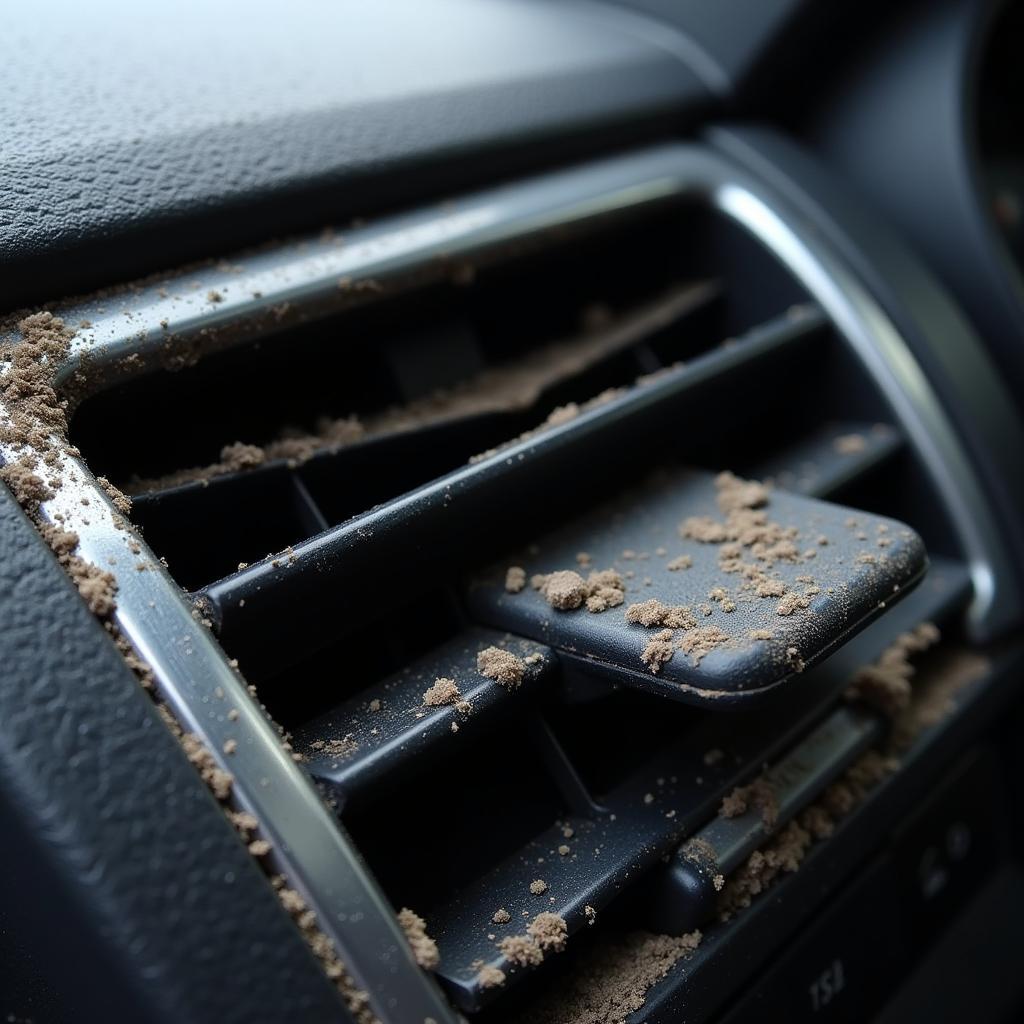A smelly car AC system isn’t just unpleasant; it can signal mold or bacteria buildup. Luckily, you can often tackle this issue yourself. This guide will walk you through the steps to diagnose and eliminate that nasty smell, leaving your car smelling fresh.
Common Causes of a Smelly Car Air Conditioner
Before jumping into solutions, it’s helpful to understand what causes that foul odor. Here are some usual suspects:
- Mold and Mildew: The moist environment within your AC system creates a breeding ground for mold and mildew, especially if it hasn’t been used for a while.
- Bacteria: Just like mold, bacteria thrive in damp, dark places. They can accumulate on the evaporator case and other components, releasing unpleasant odors.
- Clogged Cabin Air Filter: This filter traps dust, pollen, and other airborne particles before they enter your car’s cabin. A clogged filter can restrict airflow and emit a musty smell.
- Refrigerant Leak: While less common, a refrigerant leak can produce a distinct, often sweet, smell. This requires professional attention.
DIY Fixes for a Stinky Car AC
Here’s a step-by-step guide to banish bad smells from your car AC:
1. Identify the Source of the Smell
- Turn on your AC: Set the fan to its highest setting and the temperature to the coldest.
- Determine the smell: Is it musty, like dirty socks (mold/mildew)? Or does it have a more acrid, almost chemical odor (possible refrigerant leak)?
 Car AC vent emitting a bad smell
Car AC vent emitting a bad smell
2. Replace the Cabin Air Filter
This is often the easiest and most effective solution.
- Locate the filter: Check your owner’s manual for the exact location. It’s usually behind the glove box or under the dashboard.
- Remove the old filter: Note the direction of the airflow arrow on the filter for installation later.
- Insert the new filter: Ensure it’s properly seated and the airflow arrow points in the correct direction.
3. Clean the AC Evaporator
This requires a bit more effort, but it’s crucial for removing stubborn mold and bacteria.
- Purchase an AC evaporator cleaner: Opt for a foaming cleaner specifically designed for car AC systems.
- Locate the evaporator drain tube: This tube allows condensation to drain outside the car. It’s typically found on the firewall near the engine.
- Feed the cleaner tube: Insert the cleaner tube into the evaporator drain tube as far as it goes.
- Dispense the cleaner: Follow the instructions on the cleaner can.
- Let it sit: Allow the cleaner to sit for the recommended time to kill mold and bacteria.
- Run the AC: Run the AC on high for a few minutes with the windows down to flush out the cleaner.
4. Use Baking Soda
Baking soda is a natural odor absorber and can help neutralize mild smells.
- Place baking soda: Put an open container of baking soda in your car overnight.
- Repeat as needed: You can repeat this process for a few days until the smell dissipates.
When to Seek Professional Help
If the smell persists after trying these DIY solutions, it might be time to consult a professional mechanic. A persistent smell, especially a sweet or chemical one, might indicate a refrigerant leak or a more complex issue requiring specialized equipment.
Tips for Preventing Future AC Odors
Here’s how to keep your car AC smelling fresh:
- Run the AC regularly: Even during colder months, run your AC for a few minutes every couple of weeks to prevent moisture buildup.
- Clean spills promptly: Food and drink spills can contribute to bacterial growth, so clean them up immediately.
- Park in the shade: Parking in the shade can help reduce the temperature inside your car and minimize condensation.
- Consider professional AC cleaning: Having your car AC professionally cleaned annually can help prevent odor-causing buildup.
Expert Insights
“Many people underestimate the importance of regular car AC maintenance,” says John Miller, a certified automotive technician with over 20 years of experience. “A simple cabin air filter replacement can make a world of difference in air quality and odor prevention.”
Sarah Jones, an environmental health specialist, adds, “Mold and mildew thrive in moist environments like car AC systems. Addressing moisture issues and ensuring proper ventilation are crucial for preventing their growth.”
Conclusion
Dealing with a stinky car AC can be frustrating, but by following these tips, you can often eliminate the odor yourself. Remember, regular maintenance is key to preventing future problems and enjoying fresh, clean air inside your car.
If the smell persists or you suspect a more serious issue, don’t hesitate to contact the automotive experts at AutoTipPro at +1 (641) 206-8880 or visit our office at 500 N St Mary’s St, San Antonio, TX 78205, United States.
FAQs
1. How often should I replace my cabin air filter?
It’s generally recommended to replace your cabin air filter every 12,000 miles or once a year, whichever comes first.
2. Can I use household cleaners to clean my car AC evaporator?
No, it’s best to use cleaners specifically formulated for car AC systems to avoid damaging sensitive components.
3. Why does my car AC smell worse after it rains?
The increased humidity after rain can create a more favorable environment for mold and mildew growth, intensifying existing odors.
4. Is it safe to drive with a smelly car AC?
While a smelly AC might not be immediately dangerous, it can indicate mold or bacteria buildup, which could potentially cause respiratory issues for sensitive individuals.
5. How can I tell if my car AC needs professional cleaning?
If DIY cleaning methods don’t eliminate the odor, or if you notice a decrease in cooling performance, it’s best to have your AC system inspected and cleaned by a professional.





Leave a Reply